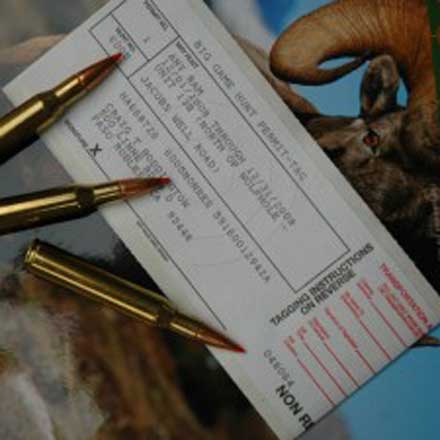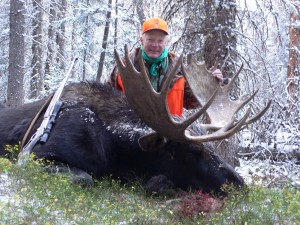
In the late afternoon we picked up fresh tracks along a snow-covered ridge, big ski-like tracks of a full-grown moose…but not big enough to be a mature bull. It could have been a youngster, but more likely a big cow. If so that was just fine. The rut was on, and she might lead us to a bull. A mile down the trail she did exactly that, and after a half-hour of playing cat and mouse in the thick timber I was standing over a beautiful bull moose. I wasn’t in Alaska, nor in Canada—and this wasn’t an Alaska-Yukon giant, nor a Canadian moose. It was the smaller, darker Shiras moose of the American Rockies, and I was in northern Colorado, just a couple hours from downtown Denver.
Obviously I drew the tag. Well, maybe not so obviously, because various state legislatures have authorized the auction of key big game tags, the proceeds going to conservation efforts. Many are opposed to these auction tags. I am not; it’s a classic example of the sacrifice of one animal for the betterment of many. But I sure can’t afford the auction tags. I drew that moose tag. Come to think of it, over the years I’ve drawn quite a few really great tags. This does take a little bit of luck, but that’s actually not the most important element.
Over the years I’ve drawn two Rocky Mountain bighorn tags, one desert sheep tag, two Shiras moose tags, three (count ‘em, three Arizona elk tags), a Rocky Mountain goat tag, and a bunch of deer and pronghorn tags. The latter two haven’t been difficult, because, honestly, I don’t put in some of the really “primo” deer, elk, or antelope tags. My calendar gets booked up pretty far ahead, so I live in terror of drawing a wonderful tag and not being able to use it—so I tend to apply for the tags that are important enough that I’ll get out of whatever else I might have planned (and you bet, every time one of these tags has arrived in the mail there has been some serious juggling).
On the several occasions that I’ve drawn these great tags I’ve gotten two fairly consistent reactions. Because of what I do for a living, a few folks have asked who I know, and how I rigged the draw. That one I can laugh about. Tag drawings today are totally computerized and open to public scrutiny. No fiddling is possible. The other, more common comment is, “Man, you’re lucky.” This is like fingernails on a blackboard. Most of the people who make this comment have never even applied! ...
The first rule in drawing tags is simple: You must apply. If you don’t apply you will not draw. Nothing else is certain.
Pronghorn tags were already on a draw basis when my Dad took me pronghorn hunting in 1965, and rifle tags in my native Kansas have been on a draw basis since the first season, also in about 1965. So applying for permits has been part of my hunting life since I was a kid. But it wasn’t until about 1978 that I got serious. Then I started applying for sheep permits, over the years expanding the states I applied in as I could afford it.

I am totally convinced that the real secret is being consistent. This is especially true today, since most states that have draw permits have some type of “preference point” or “bonus point” system. In some cases there are set-asides, so it’s possible to draw the first year (and some folks do)—but, over time, your chances increase. I’ve never drawn a great tag on the first bounce, so for me applying for tags is a matter of persistence. Once you get started you need to stay in the draw. In order to achieve consistency I use a tag drawing service. Back in 1992 I turned my own applications over to U.S. Outfitters (www.huntuso.com). They took over the applications I was already doing—sheep in Wyoming, Montana, Arizona, and Nevada; and added some more, like Shiras moose in Wyoming and Colorado, Arizona elk, and a few more sheep tags. They were the first computerized tag drawing service I’m aware of, but today there are several—and if you want to draw the really great tags, I’m convinced this is the way to go.
Clearly it has worked for me. In 1994 I drew a Montana bighorn tag. In 1998 I drew a Wyoming bighorn tag—then followed up a year later with a Wyoming Shiras moose tag. The thing about consistency is you’re there when things happen. In Wyoming I was in on the ground floor when they started their preference point system. So it was actually a mathematical certainty that I would draw both those tags between 1997 and 2000. In most cases it’s too late to get in on the ground floor with a preference point system—but over time these systems do change. They have to, because the states want...
applications, and if drawing seems to be impossible then people lose interest and quit applying.
The thing about consistency is you’re there when things happen.
After my Wyoming moose tag in ’99 I had a bit of a slow spell, but I came back strong in 2008 with an Arizona desert sheep tag, a once-in-a-lifetime tag that, to me, is one of the premier hunting opportunities of my life. George Taulman and his crew at U.S. Outfitters watch the drawings and the surveys. After consultation they put into an area in the Virgin River Canyon that has a lot of rams, but perhaps not the biggest rams in the state. The odds were a hundred to one—except, with my bonus points, my own odds were a whole lot better. Whatever they were, I beat them, had a great hunt, and took a gorgeous ram.
These things do seem to come in waves. A year later, 2009, I drew the Colorado moose tag, also by law a once-in-a-lifetime tag. George Taulman started me applying in this area in 1992, as soon a nonresident permit became available. He started his wife, Jean, and himself the same year, so we had equal preference points. Jean Taulman drew in 2008, I drew in 2009, and George hasn’t yet drawn. So there is always an element of luck—but you still must apply, and keep applying.
Right now it’s late winter, with most hunting seasons behind us and the fall season a long way off. So perhaps it isn’t the best time of year to think about hunting plans—but this is the right time, because most tag applications are due in the next few months. It’s true that I’ve drawn my fair share, and it’s likely that it will be a while before I draw another great tag. But you can bet I’m going to stay in the drawings as long as I’m healthy enough to use the tags. After all, somebody has to draw!